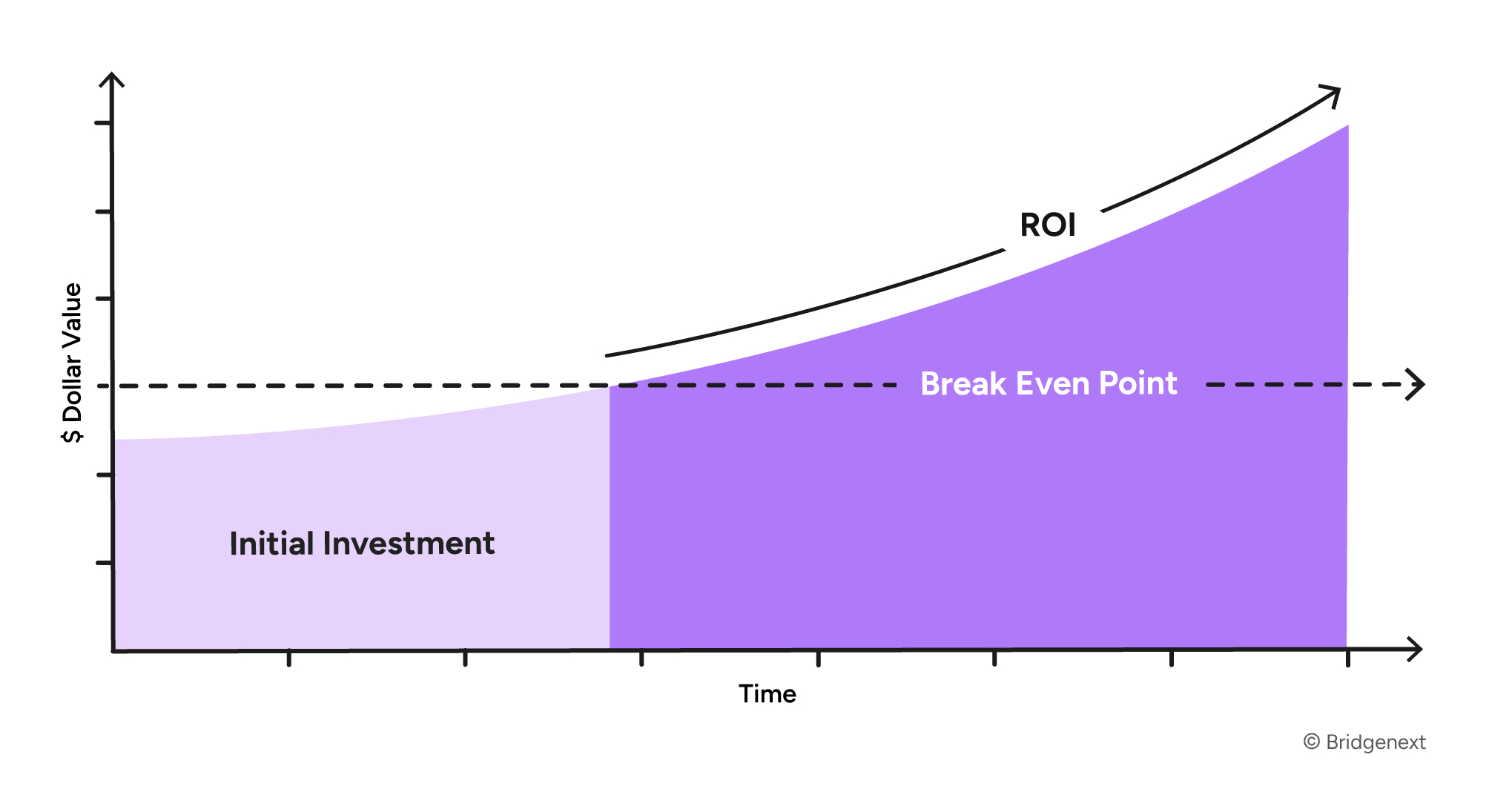11.07.24 By Bridgenext Think Tank

As we approach 2025, the conversation around the true cost of Artificial Intelligence (AI) has intensified, especially in C-level boardroom discussions. With AI firmly moving beyond hype into tangible reality, sectors like pharmaceuticals, manufacturing, airlines, transportation, logistics, and customer experience are witnessing significant successes. A Goldman Sachs report predicts that AI investment will soar to an astonishing $200 billion next year. However, such a substantial investment comes with its own set of challenges, especially for tech and consulting companies trying to determine the optimal point of entry into this dynamic arena while trying to figure out, “What’s the cost of AI?”.
We asked this question to Nandakumar Sivaraman (Nanda), Vice President (Engineering) and Data and Insights Practice Head at Bridgenext. Here are his insights on what enterprises need to consider when adopting AI and why the cost of AI goes beyond just financials.
A: The cost of AI isn’t a one-dimensional figure; it’s multi-faceted and depends on various factors. Some of the key contributors include:
In addition to this, the biggest challenge and cost is associated to the cultural shift, not the technology itself. Transitioning to an AI-centric paradigm demands organizations to embrace data-driven decision-making, continuous learning, and innovation. Overcoming resistance to change is crucial, with leadership playing a key role in communicating AI’s value. Training and trust-building are essential in aligning technology with human capital, turning cultural adjustments into an invaluable investment for innovation and growth.
A: Strategy is key to unlocking the potential of AI. Here are a few important steps:
A: Realizing AI’s return on investment requires a strategic approach and patience. Initially, costs often outweigh immediate benefits, much like plotting an X-Y axis where investment spikes early while returns lag. Early-stage AI projects, especially without a clear use case, can result in cost overruns and misaligned goals.

To address this, many companies adopt a Center of Excellence (COE) framework to align resources and guide AI initiatives toward high-impact outcomes. Early AI projects may start in a “High Cost, Low Benefit” quadrant, but the COE helps prioritize efforts for long-term gains. Research shows that effective use case optimization can improve ROI by over 50% within two to three years. This mirrors the adoption of the internet and cloud 30 years ago—despite early uncertainty, the long-term benefits have been substantial for those who invested strategically.
A: There is no single “true” cost to AI because it’s as much about opportunity as it is about resources. Reflecting on the digital adoption wave of the internet and cloud technologies three decades ago, organizations faced a landscape filled with skepticism and uncertainty. At that time, the decision to integrate these innovations was surrounded by ambiguity and a lack of concrete cost structures, much like today’s AI investments. Yet, visionary enterprises took the plunge, driven by the potential these technologies promised. As pioneers navigated opaque pricing models and uncertain returns, they laid the groundwork for the transformative digital economies we witness today.
Yes, there are costs tied to infrastructure, talent, and data, but AI opens new doors—whether it’s through innovation, efficiency, or creating new revenue streams.
AI helps businesses stay competitive by enhancing customer experiences and improving operational efficiency. For those who invest strategically, the returns can be significant.
A: The real cost of AI is not in dollars—it’s in missed opportunities for those who hesitate. AI is not a fixed expense; it evolves with time, technology, and business needs. Some companies may need to invest heavily upfront, while others can grow their AI capabilities gradually.
At Bridgenext, we recognize that the cost of AI is not just a financial consideration. We guide businesses through every step of the AI journey, helping them understand the true value of AI and how to maximize it. Companies that hesitate today may find themselves behind the curve tomorrow, missing out on the growth and efficiency AI can deliver.
Bridgenext’s forward-thinking approach positions it as a leader in guiding companies through the complexities of AI adoption. As AI continues to evolve, organizations that take a strategic, well-rounded approach will be the ones that come out on top.

Vice President (Engineering) and Data and Insights Practice Head at Bridgenext
Nandakumar Sivaraman is a digital transformation leader. His 20+ years of experience in IT spans multiple sectors including supply chain management, logistics and transportation, and fintech. He has been responsible for pre-sales, business requirements, solutioning and technical architecture planning, service delivery, and project management.
In recent years, Nanda has helped guide clients through their digital transformation initiatives involving cloud, big data, analytics, mobility, and more. He also helps organizations map their business processes to technology investments and build scalable enterprise applications to support core business needs.
Reference
www.goldmansachs.com/insights/articles/ai-investment-forecast-to-approach-200-billion-globally-by-2025